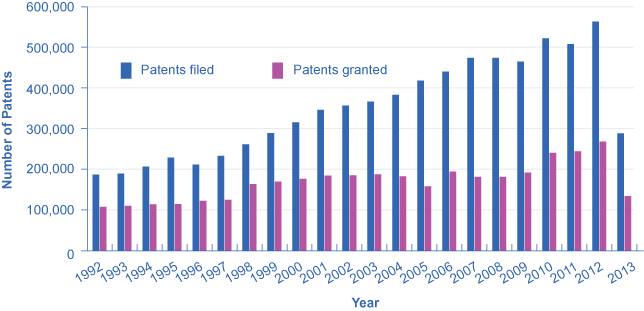Learning Objectives
- Explain the effects of intellectual property rights on social and private rates of return.
- Identify three U.S. Government policies and explain how they encourage innovation
A number of different government policies can increase the incentives to innovate, including: guaranteeing intellectual property rights, government assistance with the costs of research and development, and cooperative research ventures between universities and companies.
Intellectual Property Rights
One way to increase new technology is to guarantee the innovator an exclusive right to that new product or process. Intellectual property rights include patents, which give the inventor the exclusive legal right to make, use, or sell the invention for a limited time, and copyright laws, which give the author an exclusive legal right over works of literature, music, film/video, and pictures. For example, if a pharmaceutical firm has a patent on a new drug, then no other firm can manufacture or sell that drug for twenty-one years, unless the firm with the patent grants permission. Without a patent, the pharmaceutical firm would have to face competition for any successful products, and could earn no more than a normal rate of profit. With a patent, a firm is able to earn monopoly profits on its product for a period of time—which offers an incentive for research and development. In general, how long can “a period of time” be? The Clear it Up discusses patent and copyright protection timeframes for some works you might have heard of.
How long is Mickey Mouse protected from being copied?
All patents and copyrights are scheduled to end someday. In 2003, copyright protection for Mickey Mouse was scheduled to run out. Once the copyright had expired, anyone would be able to copy Mickey Mouse cartoons or draw and sell new ones. In 1998, however, Congress passed the Sonny Bono Copyright Term Extension Act. For copyrights owned by companies or other entities, it increased or extended the copyright from 75 years to 95 years after publication. For copyrights owned by individuals, it increased or extended the copyright coverage from 50 years to 70 years after death. Along with protecting Mickey for another 20 years, the copyright extension affected about 400,000 books, movies, and songs.
Figure 1 illustrates how the total number of patent applications filed with the U.S. Patent and Trademark Office, as well as the total number of patents granted, surged in the mid-1990s with the invention of the Internet, and is still going strong today.

While patents provide an incentive to innovate by protecting the innovator, they are not perfect. For example:
- In countries that already have patents, economic studies show that inventors receive only one-third to one-half of the total economic value of their inventions.
- In a fast-moving high-technology industry like biotechnology or semiconductor design, patents may be almost irrelevant because technology is advancing so quickly.
- Not every new idea can be protected with a patent or a copyright—for example, a new way of organizing a factory or a new way of training employees.
- Patents may sometimes cover too much or be granted too easily. In the early 1970s, Xerox had received over 1,700 patents on various elements of the photocopy machine. Every time Xerox improved the photocopier, it received a patent on the improvement.
- The 21-year time period for a patent is somewhat arbitrary. Ideally, a patent should cover a long enough period of time for the inventor to earn a good return, but not so long that it allows the inventor to charge a monopoly price permanently.
Because patents are imperfect and do not apply well to all situations, alternative methods of improving the rate of return for inventors of new technology are desirable. Some of these possible alternative policies are described in the following sections.
Policy #1: Government Spending on Research and Development
If the private sector does not have sufficient incentive to carry out research and development, one possibility is for the government to fund such work directly. Government spending can provide direct financial support for research and development (R&D) done at colleges and universities, nonprofit research entities, and sometimes by private firms, as well as at government-run laboratories. While government spending on research and development produces technology that is broadly available for firms to use, it costs taxpayers money and can sometimes be directed more for political than for scientific or economic reasons.
Visit the NASA website and the USDA website to read about government research that would not take place where it left to firms due to the externalities.

The first column of Table 5 shows the sources of total U.S. spending on research and development; the second column shows the total dollars of R&D funding by each source. The third column shows that, relative to the total amount of funding, 26% comes from the federal government, about 67% of R&D is done by industry, and less than 3% is done by universities and colleges. (The percentages below do not add up to exactly 100% due to rounding.)
| Sources of R&D Funding | Amount ($ billions) | Percent of the Total |
|---|---|---|
| Federal government | $133.6 | 32% |
| Industry | $249 | 60.2% |
| Universities and colleges | $12.5 | 3% |
| Nonprofits | $15.1 | 3.6% |
| Nonfederal government | $3.8 | 0.91% |
| Total | $414 | |
| Table 5. U.S. Research and Development Expenditures, 2011. (Source: http://www.nsf.gov/statistics/infbrief/nsf13313/) | ||
In the 1960s the federal government paid for about two-thirds of the nation’s R&D. Over time, the U.S. economy has come to rely much more heavily on industry-funded R&D. The federal government has tried to focus its direct R&D spending on areas where private firms are not as active. One difficulty with direct government support of R&D is that it inevitably involves political decisions about which projects are worthy. The scientific question of whether research is worthwhile can easily become entangled with considerations like the location of the congressional district in which the research funding is being spent.
Policy #2: Tax Breaks for Research and Development
A complementary approach to supporting R&D that does not involve the government’s close scrutiny of specific projects is to give firms a reduction in taxes depending on how much research and development they do. The federal government refers to this policy as the research and experimentation (R&E) tax credit. According to the Treasury Department: “. . . the R&E Credit is also a cost-effective policy for stimulating additional private sector investment. Most recent studies find that each dollar of foregone tax revenue through the R&E Tax Credit causes firms to invest at least a dollar in R&D, with some studies finding a benefit to cost ratio of 2 or 2.96.”
Visit this website for more information on how the R&E Tax Credit encourages investment.

Policy #3 Cooperative Research
State and federal governments support research in a variety of ways. For example, United for Medical Research, a coalition of groups that seek funding for the National Institutes of Health, (which is supported by federal grants), states: “NIH-supported research added $69 billion to our GDP and supported seven million jobs in 2011 alone.” The United States remains the leading sponsor of medical-related research spending $117 billion in 2011. Other institutions, such as the National Academy of Scientists and the National Academy of Engineers, receive federal grants for innovative projects. The Agriculture and Food Research Initiative (AFRI) at the United States Department of Agriculture awards federal grants to projects that apply the best science to the most important agricultural problems, from food safety to childhood obesity. Cooperation between government-funded universities, academies, and the private sector can spur product innovation and create whole new industries.
Key Concepts and Summary
Public policy with regard to technology must often strike a balance. For example, patents provide an incentive for inventors, but they should be limited to genuinely new inventions and not extend forever.
Government has a variety of policy tools for increasing the rate of return for new technology and encouraging its development, including: direct government funding of R&D, tax incentives for R&D, protection of intellectual property, and forming cooperative relationships between universities and the private sector.
Self-Check Questions
- When a neighborhood is cleaned up and kept neat, there are a number of positive spillovers: higher property values, less crime, happier residents. What types of government policies can encourage neighborhoods to clean up?
- Education provides both private benefits to those who receive it and broader social benefits for the economy as a whole. Think about the types of policies a government can follow to address the issue of positive spillovers in technology and then suggest a parallel set of policies that governments could follow for addressing positive externalities in education.
Review Questions
- Why might private markets tend to provide too few incentives for the development of new technology?
- What can government do to encourage the development of new technology?
Critical Thinking Questions
Is it inevitable that government must become involved in supporting investments in new technology?
Problems
The marginal private costs and the marginal private benefits of a firm producing fuel-efficient cars is represented in the following diagram (show the equilibrium Pmarket, Qmarket). The government would like to increase the amount of fuel-efficient cars to be produced and sold to Qsocial. One way that the government can try to increase production of fuel-efficient cars is by making them cheaper to produce, by subsidizing their production. Show, on the same graph, the amount of subsidy needed to increase the equilibrium quantity of fuel-efficient cars to Qsocial. Hint: the government is trying to affect production through costs, not benefits.
References
United States Department of the Treasury. “Research and Experimentation Tax Credit.” Accessed November 2013. http://www.treasury.gov/press-center/news/Pages/investing-in-us-competitiveness.aspx.
U.S. Patent and Trademark Office. 2015. “U.S. Patent Statistics: Calendar Years 1963–2014.” Accessed April 10, 2015. http://www.uspto.gov/web/offices/ac/ido/oeip/taf/us_stat.pdf.
United for Medical Research. “Profiles of Prosperity: How NIH-Supported Research Is Fueling Private Sector Growth and Innovation.” Introduction. Accessed January 2014. http://www.unitedformedicalresearch.com/wp-content/uploads/2013/07/UMR_ProsperityReport_071913a.pdf.
Glossary
- intellectual property
- the body of law including patents, trademarks, copyrights, and trade secret law that protect the right of inventors to produce and sell their inventions
Solutions
Answers to Self-Check Questions
- Government programs that either pay for neighborhood clean-up directly or that provide reduced tax payments for those who clean up or fix up their own property could be enacted. It is also easy to imagine how a city might allow its businesses to form a group that would pay for and manage neighborhood cleanup.
- Government programs that either pay for education directly or that provide loans or reduced tax payments for education could create positive spillovers. A city might allow its businesses to form a group that would coordinate business efforts with schools and local colleges and universities—allowing students to obtain real-world experience in their chosen fields and providing businesses with enthusiastic, trained workers.

